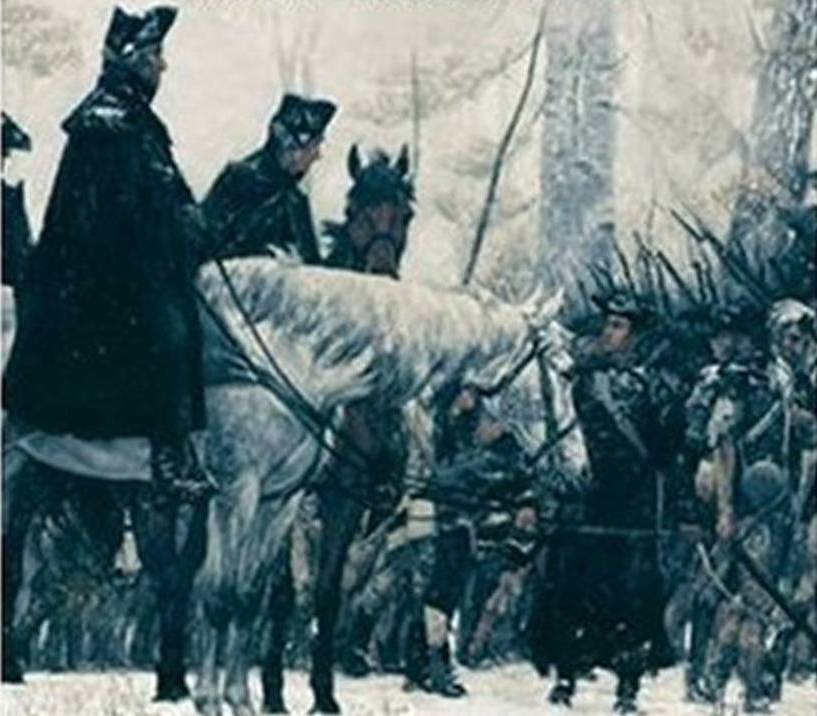Dec.26.2010
5:17 pm
by Ed Beakley
Christmas 1776: The Crossing
Boundary Condition #3 (1)
Christmas night 1776: As General Washington kneels to pray, the candle of life for an emerging ideal flickers, a river, a bitter cold march, a battle and the fate of a nation await. Even in victory, much defeat is still to come with yet another horrible winter at Valley Forge to be survived. He is no great battle captain, yet he holds the Continental Army together until victory in 1783. Abigail Adams: “I am apt to think that our later misfortunes have called out the hidden excellencies of our commander-in-chief. Affliction is the good man’s shinning time.” General Nathanael Greene: “He will be the deliverer of his own country.”
Early on the morning of December 26th, 1776, Washington’s force surprised and defeated the Hessian garrison at Trenton losing only two men, and they froze to death on the march not in the battle. Contrary to popular belief, the Hessians were not a sluggish hungover group from Christmas partying. They had earlier responded to a small incursion by another unit of the Continental Army without Washington’s knowledge. Washington was furious when he learned that his surprise was compromised, but fate was with him. The Hessian commander having ordered a search of the surounding area and finding no other troops, in deference to the worsening weather brought in his pickets.
Americans all, know the story of the incredible game changing December 26th victory against the Hessians at Trenton, but the more telling story is not that of the battle, but rather it is of the “march.” Planned with three attacking elements, two are unaccomplished because of ice in the Delaware River. Breaking camp at two in the afternoon Chrismas day, the conditions of the river and the winter storm cost three hours in the Delaware crossing. Given the need for surprise and a dawn attack, it would have not been considered cowardly to abandon the attack. Washington never hesitated, explaining later to John Hancock, ” I well knew we could not reach Trenton before day was fairly broke, but … I was determined to push on at all events.”

The audacious decision to attack across an icy river in the worst of winter weather resulted in a victory that made a piece of paper - expressing with some most excellent words an incredible concept – a living thing, an ideal we celebrated this past July 4th for the 234th time. The “crossing story” particulary focusing on the “march” was the subject of the PWH post for this past Fourth of July, closing with
We celebrate our country’s birthday in the warmth of summer recalling the day we declared our right as free and independent states, the day the signers pledged their lives, fortune and sacred honor, but we would do well to also recall a bitter cold Christmas night, a general and an army that made it so.
In research for that post, frankly I was embarassed by what I had forgotten and worse what I had never learned. Since, I have become increasing intrigued by Washington as leader in a revolution. Guerrilla, irregular, hybrid warfare are the current terms for what our military face following the events of September 11th, 2001. Following from the “little” Red Book of Mao Tse-tung, insurrgents/rebels must fight so as to survive while the government must actually defeat the guerrilla force.
The American Revolutionary War might well be considered a “hybrid” in that much of the war was fought as European armies of the day fought, but in the South, the actions of notable leaders such as Francis Marrion were pure hit and run guerrilla warfare tactics. And Washington’s army went from defeat to defeat, yet survived, maneuvering so as to fight another day. He was no great battle captain – he lost more than he won – but through will and leadership, held the Continental Army together long enough to receive training at Valley Forge, to “dodge and weave” until he received assistance from France … long enough to win the day.
It would seem worth study and reflection given a focus on decision making in worst cases and unconventional crisis. And so this becomes the third boundary condition in a search for intersections for Project White Horse 084640 in the coming year.
References:
Washington by Ron Chernow
Washington’s Crossing byDavid Hackett Fischer
Almost a Miracle by John Ferling
1776 by David McCulloughg
To Try Men’s Souls by Newt Gingrich and William R. Forsthen
A final note: The July4th post identified a painting as depicting Washington observing his troops Christmas night on the March to Trenton. Indeed, it reflects one year later, the march to Valley Forge and that horrible winter that despite the upswing from victories at Trenton and Princeton could have been the ruin of the Continental Army. Yet they survived and most importantly they trained and they learned. Despite the time frame represented by the picture, what remains the same…
one requires little imagination to guess Washington’s mind. How heavy was the burden of the multiple defeats, knowing there might not even be an army come the spring, knowing that defeat here most certainly would be the end to the revolution, and indeed, how heavy on his mind was the responsibility created by the words of the July 4th Declaration?
More to come.
Filed in 2011 Boundary Conditions,Intersections,What Kind of War | Comments Off


